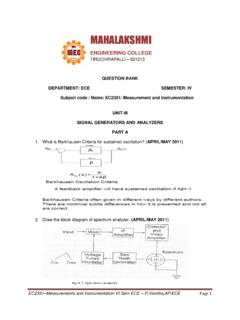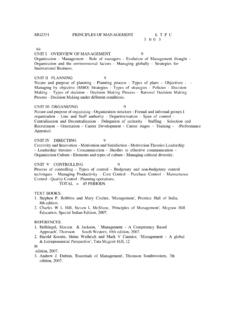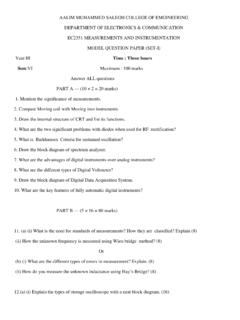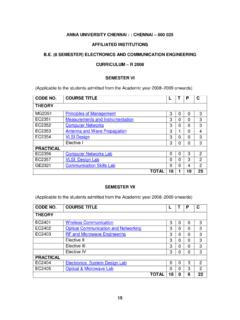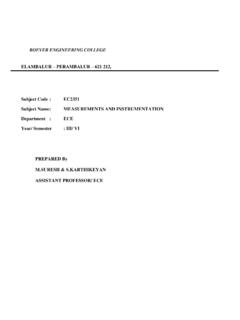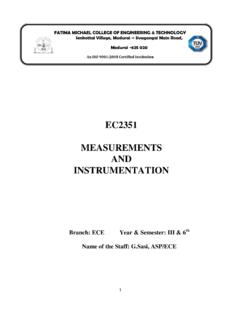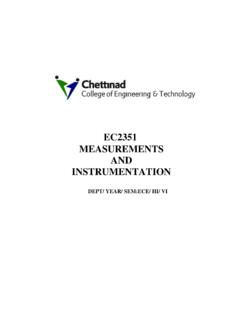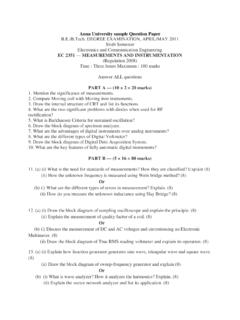Transcription of MAHALAKSHMI
1 ec2351 Measurements and instrumentation VI Sem ECE ,AP/ECE Page 1 MAHALAKSHMI ENGINEERING COLLEGE TIRUCHIRAPALLI 621213 QUESTION BANK DEPARTMENT: EEE SEMESTER: III Subject code / Name: measurement and instrumentation UNIT I- BASIC measurement CONCEPTS PART A 1. What are the basic elements of a generalized measurement system? (Nov 2003 ECE). 2. Define the term precision . (Nov 2003 ECE). A measure of the consistency or repeatability of measurements, successive readings does not differ. (Precision is the consistency of the instrument output for a given value of input). 3. List any four static characteristics of a measuring system. (May 2004 ECE). ec2351 Measurements and instrumentation VI Sem ECE ,AP/ECE Page 2 The static error of a measuring instrument is the numerical difference between the true value of a quantity and its value as obtained by measurement , repeated measurement of the same quantity give different indications.
2 Static errors are categorized as gross errors or human errors, systematic errors and Random errors. 4. Define the term Accuracy . (May 2005, Nov 2005 ECE). The degree of exactness (closeness) of a measurement compared to the expected (desired) value. 5. What are the two basic factors in specifying the dynamic performance of an instrumentation system? (Nov 2005 ECE). Instruments rarely respond instantaneously to changes in the measured variables. Instead, they exhibits lowness or sluggishness due to such things as mass, thermal capacitance, fluid capacitance or electric capacitance. In addition to this, pure delay in time is often encountered where the instrument waits for that fluctuate with time. Therefore, the dynamic and transient behavior of the instrument is as important as the static behavior.
3 The dynamic behavior of an instrument is determined by subjecting its primary element (sensing element) to some unknown and predetermined variations in the measured quantity. The three most common variations in the measured quantity are as follows: Step change in which the primary element is subjected to an instantaneous and finite change in measured variable. Linear change, in which the primary element is following a measured variable, changing linearly with time. Sinusoidal change, in which the primary element follows a measured variable, the magnitude of which changes in accordance with a sinusoidal function of constant amplitude . The dynamic characteristics of an instrument are (i) speed of response, (ii) Fidelity, (iii) lag, and (iv) dynamic error. 6. Mention the different types of standards in measurement .
4 (Nov 2005 ECE). International standard Primary standard Secondary standard Working standard 7. What is meant by calibration ? (Nov 2005 ECE). It is the process by which comparing the instrument with a standard to correct the accuracy. Types of Calibrations 1. Direct Calibration Calibration 8. Compare attraction and repulsion type instruments. (May 2006 ECE) Attraction type ec2351 Measurements and instrumentation VI Sem ECE ,AP/ECE Page 3 The moving is flat disc which eccentrically mounted. When the current to be measured flows through the coil magnetic fields is produced with attracts the moving iron towards it, thus making the pointer to mover. Controlling torque is provided by springs. Repulsion type Moving iron repulsion type instruments consist of two vanes inside the coil.
5 Among the two vanes one is fixed and the other is movable. When the current to be measured flows through the coil both the vanes get magnetized in a similar way and hence a force of repulsion a force repulsion exist between the two vanes which results in the movement of the moving vane and thus the movement of the pointer. 9. Differentiate Zero drift and span drift. (May 2006 ECE) If the whole calibration gradually shifts due to slippage, permanent set or undue warming up of electronics tube circuits, zero drift sets. 10. Differentiate accuracy from precision.(Nov 2009/May 2010) Accuracy Precision Accuracy refers to degree of closeness of the measured value to the true value Precision refers to degree of agreement among of readings Accuracy gives the maximum error that is maximum departure of the final result from its true value Precision of a measuring system gives its capability to reproduces a certain reading with a given accuracy 11.
6 In a wheatstone bridge a change of 6 in the unknown arm of the bridge is required to produce a change in deflection of mm of the galvanometer. Determine sensitivity and deflection factor. (Nov 2009) 12. Mention the significance of measurements. (APRIL/MAY 2011) A standard is physical representation of a unit of measurement . A known accurate of physical quantity is terms as standard. These standard are used to determine the value of other physical quantities by the comparison method 13. Compare Moving coil with Moving iron instruments. (APRIL/MAY 2011) Moving coil instruments Moving iron instruments Uniform sale Non uniform scale It can be used for both ac measurements It can be used for both ac and dc measurements Cost is high Cost is less It is free from hysteresis error Serious error occur due to hysteresis 14.
7 A 0-150v voltmeter has guaranteed accuracy of 1% full scale reading. The voltage measured by this instrument is 83v. calculate the limiting error in percent(NOV/DEC 2011) ec2351 Measurements and instrumentation VI Sem ECE ,AP/ECE Page 4 15. What is the difference between a primary and secondary standard (NOV/DEC 2011) Primary standard Secondary standard The main function of primary standard is the calibration and verification of secondary standard Secondary standard are basic reference standard used by measurement and calibration of working standard Primary standard are maintained at the national standard lab is different countries Secondary standard are maintained at the industries. Each industry has its own secondary standard 16. What Are The Various Static Characteristic Of An Instrument ?
8 The Various Static Characteristics Of A Measuring System Are Accuracy, Precision, Error, Resolution, Sensitivity, Linearity, Zero ,Drift Etc. 17. Define Accuracy And Precision . Accuracy : It Is The Degree Of Closeness With Which The Instrument Reading Approaches The True Value Of The Quantity To Be Measured. Precision : It Is The Measure Of Consistency Or Repeatability Of Measurements. It Denotes The Closeness With Which Individual Measurements Are Departed Or Distributed About The Average Of Number Of Measured Value. 18. What meant by accuracy of an instrument? The degree of exactness (closeness) of a measurement compared to the expected (desired) value. 19. What is calibration? It is the process by which comparing the instrument with a standard to correct the accuracy. Types of Calibrations Direct Calibration Indirect Calibration 20.
9 Define the terms precision & sensitivity. 21. What is standard? What are the different types of standards? ec2351 Measurements and instrumentation VI Sem ECE ,AP/ECE Page 5 A standard is a physical representation of a unit of measurement . The term standard is applied to ac piece of equipment having a known measure of physical quantity. Types of Standards International Standards (defined based on international agreement ) Primary Standards (maintained by national standards laboratories) Secondary Standards ( used by industrial measurement laboratories) Working Standards ( used in general laboratory) 22. What are the basic elements of a generalized measurement system? (Nov 2003 ECE). The basic elements of a generalized measurement system are (i) Primary sensing unit (ii) Data conditioning unit (iii) Display unit.
10 23. Define the term precision . (Nov 2003 ECE). A measure of the reproducibility of measurement given a fixed value of Variable, precision is a measure of the degree to which successive measurement differ from one another. 24. What are the classifications of errors in measurements? (Nov 2004 ECE). The classifications of errors are (i) Gross errors (ii) Systematic errors (iii) Schematic errors (iv) Random errors 25. List any four static characteristics of a measuring system. (May 2004 ECE). Some of the static characteristics of a measuring system are (i) Accuracy, (ii) Sensitivity (iii) Drift (iv) Hysteresis (v) Dead zone (vi) Linearity 26. Define the term Accuracy . (May 2005, Nov 2005 ECE). Accuracy refers to the degree of closeness or conformity to the true value of the quantity under measurement 27.
